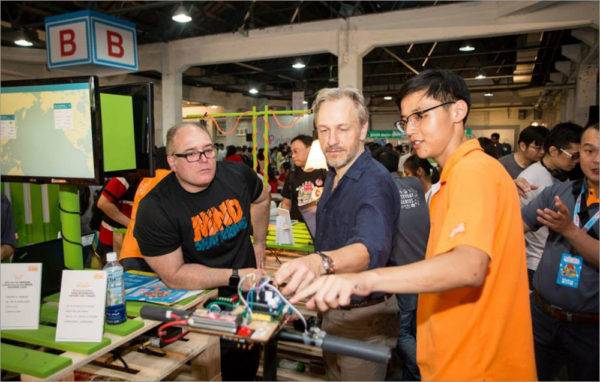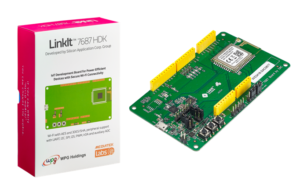As a leading edge chip manufacturer, MediaTek has been helping companies and developers get to market for almost two decades. Philip Handschin is a technical account manager, which sounds a little boring until you realize he gets to travel the world helping their community of developers use their Hardware and Software Development Kits. He crosses the globe attending events to evangelize, working with developer shops and supporting hackathons and provides technical support to direct customers. And that puts him at the front lines of people developing for IoT, as well as the leading edge of their concerns.
ReadWrite: As you talk to developers, what are the concerns you are hearing as people try to get engaged with this connected world.
Philip Handschin: The biggest concern at the moment is definitely security because we see these stories about hacked calls on mobile and the biggest hack of email addresses. Since the number of connected things in the era of IoT is expected to outnumber that of PCs or mobile phones by a factor of 100-1,000 in just a few years’ time, security concerns need to be taken seriously.
RW: And as you have developed your products and your developer boards, that’s something you’ve been baking in from day one, haven’t you?
PH: Absolutely! Especially with the latest one, the LinkIt 7687 HDK by SAC, which has a security engine built into it. And now you have this connection into the cloud, but that makes you also vulnerable right? You have to secure the line to the cloud, that’s kind of crucial. With the LinkIt 7687 HDK, you can build a broad range of Smart Home devices with secure Wi-Fi connectivity, including connected appliances, home automation devices, and more.

The thing is, MediaTek is a big company. And we have many years of experience, not just in IoT. We are very big in smartphones where security is important as well, we are big in set-top boxes and Wi-Fi routers. We have been around the block with these devices, so we already knew going into IoT that these things had to be secure.
For instance, the LinkIt software development kit (SDK) offered as part of the MediaTek LinkIt Development Platform for RTOS and supporting multiple chipsets and hardware, including the MT7687 chipset and LinkIt 7687 HDK, already has built-in tools for compiling a new software build, package checking, and then sending it over the air to the device and deploying it remotely. That’s important because you might not get it right the first time and you may need to update later once the device is already maybe built into your wall or built into your car.
RW: Well, it’s more than important. We are already seeing the risk of not building a patch and update path on day one, and we saw it with the recent DDoS IOT attack. And now we have all these connected home products, but many were never really given a mechanism for doing updates and hackers are now taking advantage.
PH: Yeah, you’re right. I am a bit of a petrol head, so I was scared when they hacked the Jeep Cherokee and they could kind of deactivate the engine. You have to have the right approach by integrating firmware updates over the air so you can basically manage it overnight if you detect a security hole.
RW: So this is all doom and gloom, I don’t want to just do that. On the upside, you get to talk to all these developers, and you get to be at these hackathons. What are some of the really surprising things you’ve seen people do with your products?
PH: I think it’s just the sheer breadth of applications they come up with. We have seen many examples for the Smart Home. Someone had a home improvement project with a laundry alert system, for example, where you could chuck in your wash and once the wash was finished it sent you a text message. Another example using the LinkIt ONE board was an intruder alarm; if someone opened the door, a motion detector triggered a text message direct to your phone.
RW: And interacting with developers is a great opportunity to see what people are doing with your technology and have a wonderful feedback loop. As you have talked to these developers, has there been functionality or connectivity that you are now considering or have baked into your products based on what you are seeing people do?
PH: So when we launched our first IoT development platform, the MediaTek LinkIt ONE,a little over two years ago, we really wanted to have an HDK that can do it all. And I think we delivered it because we have Global Positioning on there, we have Wi-Fi connectivity, we have Bluetooth and Bluetooth Low Energy and also wireless connectivity with 2G/2.5G (GSM/GPRS). Thanks to all its connectivity features, it became a very popular HDK among makers of do-it-yourself projects but also used by many professional developers for proof-of-concept of new IoT solutions.
And then, , we had feedback from developers and realized there was a demand especially in home automation for something a lot simpler, so we introduced our first “smart home” geared platform early last year, the LinkIt Connect 7681, which can be used to create simple smart plugs, connected light bulbs and such.
We also saw a demand for a more advanced, “smarter” offering, so we late last year launched the MediaTek LinkIt Smart 7688 platform, which is open source and widely supported by the community. This can be used to create advanced Wi-Fi enabled products for the smart home or office, such as IP cameras, surveillance devices, smart appliances and Wi-Fi gateways that make use of cloud services.
The cool thing with the LinkIt Smart 7688 platform is not only that you have Linux running on the development board with a powerful chip, but we actually have two versions of HDK and support multiple programming languages. The device can actually be controlled on the Linux side with like Python or Node.js or a high-level language, it doesn’t have to be C because some developers are maybe a bit scared when they can only do C. Supporting high-level languages makes the platform an ideal route into IoT development for mobile and web developers. The LinkIt Smart 7688 Duo HDK has an Atmel chip on there which supports Arduino. This means you can also connect Arduino sensors and use the popular Arduino IDE.
RW: And you have continued to benefit from this feedback from the developers with your new boards right?
PH: So we saw that a community-driven open source solution was really key but we also wanted to go more professional, in a way that you can start with our boards and finish with our boards as well, and go right into mass production with very simple and quick steps.
So now we have the LinkIt 7687 HDK which is co-designed with and developed by a partner called Silicon Application Corp. The MediaTek MT7687 chipset is based on the latest ARM Cortex-M4 architecture and is very power efficient. The LinkIt SDK is based on FreeRTOS which is the default standard for embedded devices. It’s an open source real-time operating system with a large community of support and it’s also used in a wide range of industrial devices so it’s the best of both worlds.
It’s important because if you are based on an OS that only you use, then not many people can help you. But if you go with a popular operating system then you put it out there and a problem will be solved for you. And we provide the whole developer chain, from a debugger to a flash tool, all this with lots of tutorials and example codes to get you up and running quickly. With reusable reference design and the Wi-Fi SoC based module you can go quickly into mass production as well.
RW: If someone is deciding to break into IoT to build something, what are the most helpful advice you could give them to successfully prototype an IoT device?
PH: Buy a MediaTek board and visit the MediaTek Labs portal to get you started! If they are starting completely fresh then buying an Arduino compatible board is a great starting point because although it is kind of close to C, the language is still very, very easy to understand.
And it’s just another programming language, so just do it! Don’t be scared because we really want to encourage developers to buy a board and just connect a few sensors and program it. We are developers ourselves after all, and we know what is important. That’s why we have created example code, documentation, and tutorials to get you started. So you know, just take some example and go from there, change a few lines and see what’s happening.










